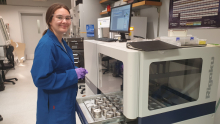
University:
Major:
Mentor(s):
Faculty Sponsor(s):
Faculty Sponsor's Department:
Project Title:
Project Description:
Zeolites are the one of the most important classes of solid catalysts. They represent over 40% of all solid catalysts used industrially, from the pharmaceutical industry to catalytic cracking in petroleum refining, and considerable efforts have been devoted to understanding the zeolite structures and their catalytic reaction properties. In an industrial setting, zeolite powders are mixed with binders, typically alumina, and extruded into pellets or spheres with millimeter dimensions. This is done to minimize pressure drop in large-scale reactors. The addition of the binder has historically been considered as part of the scale-up process and has received little attention in academic research. However, recent work has shown that the binder and interactions between the zeolite and binder may play an important role also in catalyst performance. The aim of this project is to characterize the atomic-scale compositions and structures of bifunctional Pt-containing H+-USY zeolite catalyst, in both its native powder form and in combination with an alumina binder. Platinum was added to the zeolite powder and zeolite-alumina extrudate via ion exchange and impregnation, respectively. The chemical compositions of the materials were characterized using X-ray fluorescence (XRF) spectroscopy. X-ray diffraction (XRD), and N2-adsorption porosimetry were used to analyze the zeolite framework structure and its nanoscale porosity. Solid-state two-dimensional Nuclear Magnetic Resonance (NMR) spectroscopy was used to measure interactions between the binder and the zeolite, and the local environment of the platinum. Lastly, CO-adsorption Fourier-transform infrared (FTIR) spectroscopy was used to determine the distribution and oxidation state of platinum. The resulting structural insights can be correlated with the reaction properties to further our understanding of the role of the binder on the performance of platinum-zeolite catalysts.
